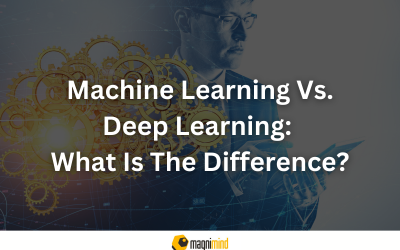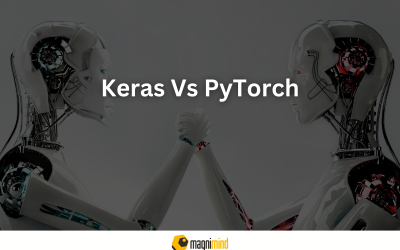In recent times, both the terms ‘machine learning’ and ‘deep learning’ are creating a huge buzz around the AI landscape. The world is steadily becoming an artificial intelligence-first one where digital assistants together with other services act as our primary source of information. This concept is backed by the two terms we just mentioned. Both deep learning and usual machine learning are methods of teaching AI to perform tasks.
Though some people use these terms interchangeably, they’re not the same. In this post, we’re going to learn the differences between deep learning and usual machine learning based on various factors. But before delving deeper, let’s have a look at what these terms actually stand for.
Machine learning
In its most basic form, machine learning is a method to implement artificial intelligence. Machine learning algorithms parse data, learn from it, and then apply that learning to make informed decisions. To understand how these algorithms work, consider an on-demand music streaming service that recommends new artists or songs based on a listener’s preferences and similarities with others. Usual machine learning is widely used to automate tasks across industries—from finance professionals identifying favorable trades to data security firms detecting malware. When we refer to something capable of machine learning, we mean it can perform a function using input data and progressively improve at that function. Most often, machine learning algorithms operate on specific features extracted from raw data, such as time values for signals or pixel data for images. In highly personalized fields like digital gaming and sports wagering, this capability becomes especially important—for example, helping users better understand what to know about AZ sportsbook bonuses, where data-driven insights can clarify terms, boost decision-making, and improve user engagement.
It’s important to understand that an algorithm isn’t a complete computer program which is a set of instructions. It’s a limited sequence of steps required to solve a specific problem. For instance, a search engine depends on an algorithm which grabs the text entered into the search box by a user and searches the associated database to come up with related search results. It takes certain steps to achieve a specific goal.
Different types of learning algorithms are used in machine learning. Let’s have a quick look at them.
- Supervised learning: It’s a learning technique where the entire learning process is governed. Here, the key goal of algorithms is to predict the outcome when a set of training samples is provided together with the training labels. For example, if the assigned goal is to distinguish between pictures of boys and girls utilizing an algorithm for sorting images, the ones with a male child would come with a ‘boy’ label and those with a female child would appear with a ‘girl’ label. It’s treated as a ‘training dataset’ and those labels remain in place until the program can sort the images successfully at an acceptable rate.
- Unsupervised learning: Unlike the previous technique, here you don’t have any training labels for the training purposes. Here, the algorithms are formulated in a manner so that they can find suitable patterns and structures in the data. In this technique, any of the two methods is used to perform the assigned task. One is called ‘clustering’ which groups similar objects together. The other method is called ‘association’ where the task is performed by determining a common pattern between the objects.
- Reinforcement learning: This technique comes with an agent which learns how to behave in a particular environment by taking steps and quantifying the results. Chess can be considered as an excellent example of reinforcement learning. The program understands the rules of chess and how to play, and takes step by step actions to complete a round. The only information given to the program is whether it lost or won the match. If it loses the match, the game is replayed by the program, keeping track of the successful moves, until it wins a match finally.
That’s all about the fundamentals of usual machine learning. Now, let’s understand what deep learning is all about.
Deep learning
Though deep learning has been around for some time now, these days it’s getting more attention because of widespread adaptation. It’s a subset of machine learning and also comes with supervised, unsupervised, and reinforcement learning. Though deep learning is inspired by the way the human brain works, it needs high-end machines and huge amounts of big data to provide optimum performance. Unlike usual machine learning algorithms which break problems down into different parts and individually solve them, deep learning solves a problem from end to end. A deep learning technique is capable of learning categories incrementally via its hidden layer architecture. Probably the biggest advantage of using this technique is the more data you feed deep learning algorithms, the better they get at solving a task. And technology’s ‘Big Data Era’ is capable of providing massive amounts of opportunities for innovations in deep learning. There’s an array of methods are used in this technique. Some of these include convolutional neural network, recurrent neural network, generative adversarial network etc. In the earlier example for usual machine learning, where images of boys and girls were used, algorithms were used by the program to sort those images based on spoon-fed data mainly. But with deep learning, there’s no data given to the program to use. It scans every pixel within an image to identify edges which can be used to separate a boy from a girl. Then it’ll put shapes and edges into a ranked order of probable importance in order to determine those two genders.
Differences between deep learning and usual machine learning
Now that you’ve gained an overview of usual machine learning and deep learning, it’s time to learn about the differences between both based on some important points.
Data Dependencies
The biggest difference between usual machine learning and deep learning lies in their performance as the volume of data increases. Usual machine learning algorithms usually perform well even if the volume of the dataset is small. On the other hand, deep learning algorithms require a massive amount of data to perform perfectly.
Feature Engineering
Feature engineering refers to the process of putting the domain knowledge into the modeling of feature extractors to lower the complexity of data and make the patterns more visible in order to learn the algorithms working. The process is expensive and difficult in terms of expertise and time. In usual machine learning, performance depends on hand-crafted features as inputs. Here, features stand for pixel values, textures, shape, position, orientation, and color. The performance depends on how well these features are identified and extracted. On the other hand, deep learning doesn’t rely on hand-crafted features and performs a hierarchical method of feature extraction, which means it learns features layer-wise. Hence, deep learning lowers the task of creating new feature extractor for each and every problem.
Hardware Dependencies
Usually, deep learning relies on high-end machines while usual machine learning can be performed on low-end machines. For example, GPUs (graphical processing units) are an integral part of deep learning functioning. On the other hand, you can implement a usual machine learning algorithm on a CPU with fairly standard specifications.
Training Time
Generally, deep learning algorithms need a long time to train because of the presence of a huge number of parameters. For example, a deep ResNet (deep residual network) takes around two weeks to train fully from scratch. On the contrary, usual machine learning needs much less time to train, from a few seconds to a couple of hours.
Problem-solving Technique
You need to divide a problem into different parts in order to solve it using usual machine learning. For example, you need to do multiple object detection. The task involves identifying what’s the object and where is it actually present in an image. In a usual machine learning approach, the problem would need to be divided into two steps: first is object detection and second is object recognition. On the other hand, in deep learning approach, the process would be done end-to-end. For instance, you’d need to pass in the image, and it would come out with the location together with the object’s name.
Industry Ready
Usual machine learning algorithms are generally easy to be interpreted. They’re interpretable regarding the parameter it chose and the reason behind it. On the contrary, deep learning algorithms are simply a black box. Even if those algorithms can outshine humans in performance, they’re still not reliable in the context of to be deployed in the industry.
Conclusion
Both the usual machine learning and deep learning have the potential to transform the business landscape. Machine learning is already being heavily integrated by businesses across different industries to gain a competitive advantage. Deep learning is considered one of the most high-end techniques to deliver state-of-art performances. Both of these applications have been surprising researchers each day with their capabilities to do wonders and we can expect to see this trend to be continued in the future.



